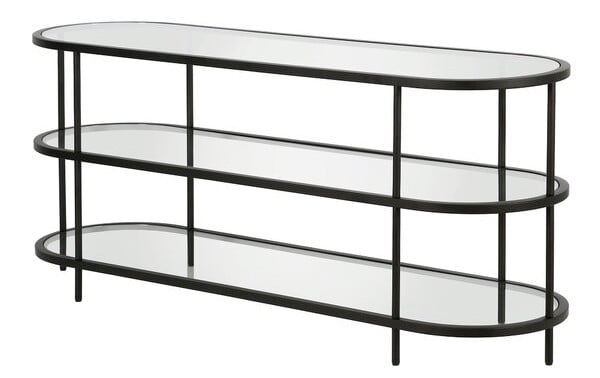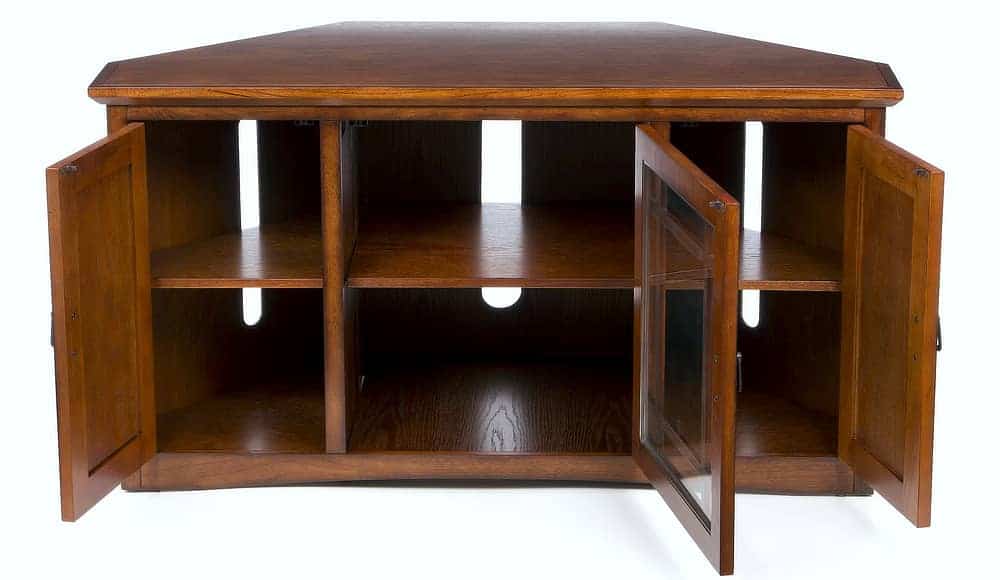Flat-screen TV stands and cabinets are an important consideration for your home theater installation.
The TV furniture that you choose is crucial to your home cinema system and your living room interior design.
The purpose of this guide is to identify the different types of TV stands and TV cabinets that are available on the market – and discuss the strengths and weaknesses of each of the different types of TV furniture.
You will also learn about the issues to check before purchasing any kind of TV or AV furniture.
Types of TV Furniture
In the early days of flat-panel televisions, the vast majority of TV units were glass TV stands.
These tended to be rectangular in design, although as many TVs are positioned in the corner of the room, it wasn’t long before corner TV stands were developed.
Not all consumers like glass TV stands, and there is now a range of wooden TV stands on the market – and these are available in the form of open TV stands and enclosed TV cabinets.
As an alternative to a wall-mounted television, companies developed mount TV stands, which are essentially traditional TV stands with an incorporated bracket giving a similar look to a wall-mounted TV.
Glass TV Stands
There are a number of considerations if you are thinking about buying a glass TV stand.
The thickness of the glass, the type of cable management and the weight of the TV you are going to put on it are all part of the equation.

Image Credit: Gold Flamingo
You will also find that there are many different colors of glass to choose from to enable you to match the stand perfectly with the decor of your room.
The glass shelves will usually come with metal supports or wooden frames.
For example, the Gold Flamingo Niko tempered glass TV stand in the picture above has a steel frame with a handcrafted finish.
Or, you might think that wooden supports would fit your room better.
So, you have a big choice in the look of the stand that you want in your room.
Go to the in-depth guide to find out more information about choosing glass flat-panel TV stands.
Wood TV Stands
Wooden TV stands might be the right choice if you prefer a more traditional look.
If your room is full of wooden furniture and flooring, then a glass TV stand may not fit into the look you want for your room.
However, a wooden TV stand brings its own issues, like solid back panels that make it difficult to ventilate, access and run cables.

Image Credit: Walker Edison
The example here of the Walker Edison Wren Classic 4 Cubby wooden TV console gives you an idea of the rustic look these stands can offer.
The guide to wood TV stands and furniture gives a more detailed look into the pros and cons of this stand type and points out some important things to consider.
Corner TV Stands
Depending on the layout of your room, it may be that a traditional wide glass or wooden stand may not fit into the space you have available.
In this instance, you may want to consider a corner TV cabinet or stand, which will fit much more easily into a smaller area.
The rear of a corner stand is shaped so that it will push back much further into the corner of the room compared to a stand with a straight edge.
This will save you space and make the TV less prominent in the room.

Image Credit: Charlton Home
One potential drawback with these corner designs is that they can provide limited space for your AV equipment – especially if the rear goes to a point to fit exactly in the corner.
Therefore, if you have a range of amplifiers, players and game consoles to install, you might need to consider where they are all going to go.
In the example above of the Stodeley Media Console wood corner TV stand – the rear is straight, with just the edges shaped for a corner.
This gives more room for equipment inside the unit.
Corner stands come in a variety of materials and styles, from metal to glass to wood – and the example above is made from wood with an antiqued paint finish.
You can find more in the guide to the corner TV cabinet and stand.
TV Cabinets
Flat-screen TV cabinets are sometimes called credenzas and are a slightly different option when compared to the other types of stand discussed here.
These offer a more enclosed space for your AV equipment and allow you to hide your devices away.
In some cases, this can be an important consideration if you don’t want your living space overtaken by technology.
However, you must also think about the impact on ventilation and access to the devices before you decide if this is the best way for you to go.

Image Credit: Sand & Stable
A good example of a TV cabinet can be seen in the picture here, the Alani Media Console.
This offers a flat surface to place your TV on the top (or you can hang it on the wall), plus there is a mixture of open areas for your equipment – and two enclosed areas behind two wood doors.
Just make sure you are aware of the potential disadvantages of large screen TV cabinets before you make your decision.
You can go here to find a more in-depth look at flat-screen TV cabinets.
TV Stands with Mounts
A flat-screen TV stand with a mount is a more modern innovation.
Also known as a TV mount stand, they can provide the shelf space and compact design of a more traditional TV stand, combined with the ability to hang the TV as if it were wall-mounted.
This can also provide you with more room for your hardware underneath the TV.
It is important that you buy the correct mount stand for your TV size. As you shop around, make sure that you check the specifications for each stand.

Image Credit: Ameriwood Home
This type of stand can also allow you to have the TV at a greater height when compared to a glass or wooden stand – which will often offer a lower viewing position when the TV is in place.
The picture above shows the Ameriwood Home Galaxy TV stand with a mount.
This model is useful as it comes with shelving for installing your AV equipment underneath the TV.
You can buy models with different amounts of shelves to suit the equipment that you have.
Go to the article about TV stands with mounts for more detailed information.
How to Choose a TV Stand
Whichever type of TV stand you choose, there are a number of general considerations which you should think about while you are making your decision.
These points are related to whichever style and design you eventually go for – but may also influence the type that you choose:
- Allow enough shelf space for all your equipment – width and depth
- Provide sufficient ventilation if your devices are hot
- Try to avoid stacking devices on top of each other
- Surround sound – do you need room for a center speaker?
- Consider the number of cables you need to run behind the unit
- Is it easy to access devices for cleaning and general maintenance?
- Will the TV stand fit into the look and decor of your room?
- Get one designed to hold the size and weight of your TV
- Check the VESA standard for your TV – and buy a stand that will fit this
Conclusion
This guide should help you to decide which TV stands for flat screens best meet your needs and will assist you when choosing the right model from the wide choice available.
The type of furniture that you buy for your room is an important consideration.
It may seem a bit boring compared to all your exciting hardware and gadgets, but buying the right stand will help to integrate your equipment into your room.
And can aid the operation and performance of your system.
About The Author
Paul started the Home Cinema Guide to help less-experienced users get the most out of today's audio-visual technology. He has been a sound, lighting and audio-visual engineer for around 20 years. At home, he has spent more time than is probably healthy installing, configuring, testing, de-rigging, fixing, tweaking, re-installing again (and sometimes using) various pieces of hi-fi and home cinema equipment. You can find out more here.




